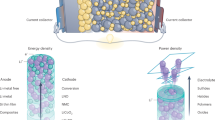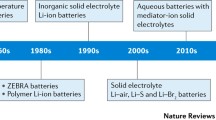Abstract
Investigations were conducted to study the feasibility of a solid-state battery system for storage applications. During the development of various high energy density solid-state batteries we noted that the solid electrolyte material, LiI dispersed in large surface area Al2O3, has a high ionic conductivity at elevated temperatures, (for example 0.1Ω−1 cm−1 at 300° C) and is suitable for high-rate storage battery applications. In solid-state battery systems both the electrodes and electrolytes are in the solid state under the operating conditions of the battery. The absence of any liquid phase makes the individual cell containers unnecessary in a multicell battery resulting in a simplified battery structure and increased package efficiency. Furthermore, no material compatibility problem is encountered in the system. As a result, the solid-state battery system has excellent charge retention characteristics and a long projected operating life. Solid-state test cells, Li-Si/LiI(Al2O3)/TaS2/Ta, Li-Si/LiI(Al2O3/TiS2/Ti and Li-Si/LiI(Al2O3)/TiS2, Sb2S3, Bi were constructed and subjected to discharge-charge cycle tests at 300±10° C, at 13·7 mA cm−2. Preliminary test results demonstrated that these solid-state battery systems are rechargeable and may be suitable for both load levelling and/or vehicle propulsion. From the considerations of material availability and cost and operational efficiencies it was concluded that the Li-Si/LiI(Al2O3)/TiS2, Sb2S3, Bi system is most suitable among the three systems studied for the development of practical storage batteries. Preliminary design studies showed that practical energy densities of 200W h kg−1 and 520 W h l−1 can be realized with the Li-Si/TiS2, Sb2S3, Bi storage batteries.
Similar content being viewed by others
References
C. C. Liang, A. V. Joshi and L. H. Barnette, 27th Ann. Proc. Power Sources Conf. (1976) 141.
C. C. Liang and L. H. Barnette,J. Electrochem. Soc. 123 (1976) 453.
C. C. Liang,ibid. 120 (1973) 1289.
C. Wagner, Proc. Int. Comm. Electrochem. Thermo. Kinetics7 (1957) 361.
A. V. Joshi and C. C. Liang,J. Phys. and Chem. Solids 36 (1975) 927.
J. H. Kennedy,J. Electrochem. Soc. 124 (1977) 865.
L. R. McCoy and L. A. Heredy, Proc. Intersoc. Energy Conversion Eng. Conf.11 (1976) 485.
J. S. Dunning, T. G. Bradley and E. J. Zeitner, Proc. Intersoc. Energy Conversion Eng. Conf.11 (1976) 491.
M. S. Whittingham,J. Electrochem. Soc. 123 (1976) 315.
M. S. Whittingham and F. R. Gamble,Mat. Res. Bull. 10 (1975) 363.
L. H. Gains, R. W. Francis, G. H. Newman and B. M. L. Rao, Proc. Intersoc. Energy Conversion Eng. Conf.11 (1976) 418.
R. A. Sharma and R. N. Seefurth,J. Electrochem. Soc. 123 (1976) 1763.
R. N. Seefurth and R. A. Sharma,ibid 124 (1977) 1207.
American Metal Marketing News (March, 1977).
Chemical Marketing Reporter (June, 1977).
Author information
Authors and Affiliations
Rights and permissions
About this article
Cite this article
Liang, C.C., Joshi, A.V. & Hamilton, N.E. Solid-state storage batteries. J Appl Electrochem 8, 445–454 (1978). https://doi.org/10.1007/BF00615840
Received:
Issue Date:
DOI: https://doi.org/10.1007/BF00615840




